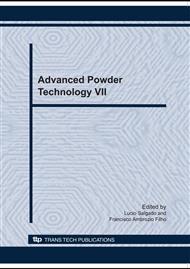[1]
J. Crane and J. Winter, Copper: Properties and alloying, Encyclopedia of Materials Science and Engineering, vol 2, Ed. MB Bewer, Pergamon Press and the MIT Press (1986), p.848 – 855.
Google Scholar
[2]
P. W. Taubenblat, Copper Selection of high conductivity alloys, Encyclopedia of Materials Science and Engineering, vol 2, Ed. MB Bewer, Pergamon Press and the MIT Press (1986), pp.863-866.
Google Scholar
[3]
ASM Specialty Handbook: Copper and Copper Alloys, Metal, chapter 1, section 1, ASM International, (2001).
Google Scholar
[4]
C. R. Brooks, Heat Treatment, Structure and Properties of Nonferrous Alloys, ed. ASM, Metals Park, 1988, chapter 8.
Google Scholar
[5]
A. Butts, Copper, the Science and Technology of the Metal, its Alloys and Compounds, ed. Reinhold Publishing Corporation, New York, 1954, 3th printing (1960).
Google Scholar
[6]
G. Gosh, J. Kiyake and M. E. Fine, JOM, March (1997), pp.56-60.
Google Scholar
[7]
A. Rotem, D. Shechtman, and A. Rosen, Metall. Trans. A Vol. 19A (1988), p.2279.
Google Scholar
[8]
D. Steiner, R. Beddoe, V. Gerold, G. Kostorz and R. Schmelczer: Scripta Metall. vol. 17 (1983), p.733.
DOI: 10.1016/0036-9748(83)90483-0
Google Scholar
[9]
A. Guha: Development of a high-strength, high-conductivity Cu-Ni-Be Alloy, high conductivity Copper and Aluminum Alloys, eds. E. Ling and P. Taubenblat W., TMS – AIME Publ. (1984), pp.133-145.
Google Scholar
[10]
Y. Sakai, K. Inoue, and H. Maeda: Acta Metall. Mater. Vol. 43 (1995), p.1517.
Google Scholar
[11]
W. A. Monteiro, F. Cosandey and P. Bandaru: Proceedings of THERMEC'97, Wollongong, Australia, July (1997).
Google Scholar
[12]
W. A. Stadtler: Production of Metallurgy Parts. ASTM, Powder Metallurgy, Ohio, (1989) p.449.
Google Scholar
[13]
M. Ghadiri, F.A. Farhadpour, R. Clift, J. P. K. Seville: Particle characterization size and morphology, The Institute of Metals Series on Powder Metallurgy - An Overview. London, (1991), p.56.
Google Scholar
[14]
Powder metallurgy - An overview. 1. Ed. The Institute of Metals Series on Powder Metallurgy, London, Great Britain, (1991).
Google Scholar
[15]
W. A. Kaysser: Solid State Sintering. The Institute of Metals Series on Powder Metallurgy - an overview. London, (1991), p.45.
Google Scholar
[16]
F. Thümmler and R. Oberacker: Introduction to Powder Metallurgy, The Institute of Materials, (1993).
Google Scholar
[17]
J. A. G. Carrió, W. A. Monteiro, V. A. Rodrigues, M. C. Terence, T. J. Masson and L. F. Miranda: European Powder Diffraction Conference – EPDIC 11, 19-22 September, Warsaw, Poland (2008).
Google Scholar


